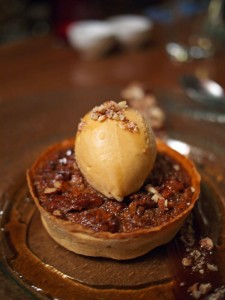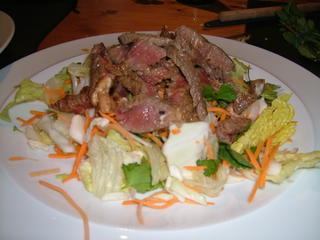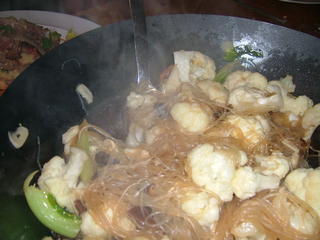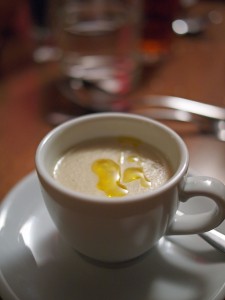
That little episode was, I think, the longest break from blogging I’ve had in about six years. I read somewhere that we are due to get flu every ten years or so, and I managed to have this decade’s dose while on a flight back from New York (scratch one week’s blogging, while I was having fun on holiday) a couple of weeks ago. It’s been exactly two weeks today (scratch another two weeks’ blogging, while I was lying in bed staring at the ceiling and wishing I was dead), and I’m still not better. But at least I can look at a monitor now without splattering goo all over it and getting a blinding headache from the backlight.
So. To the Essex/Suffolk border, where about a month ago, I was invited over to the Rose and Crown in Great Horkesley (01206 271251) for a lazy Tuesday supper. Chef and patron Ed Halls set up shop in the sort of place that estate agents describe as having a “wealth of beams” almost exactly a year ago, after spells cooking at starry places like Morston Hall in Norfolk, and Pétrus under Marcus Wareing. (And, in the spirit of full disclosure, I should mention that I discovered half-way through my meal that my buddy Krista from Passport Delicious is a part-owner of the Rose and Crown.)
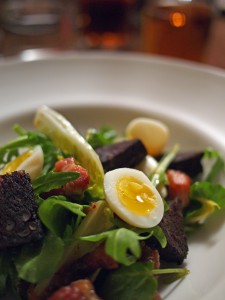
Ed marks a very clear line in the fuzzy territory between the pub scampi-in-a-basket menu and the sort of fine dining that might intimidate your gran. This is an accessible menu that you can easily put in front of the family; but it’s also full of little un-pubby gestures like a little amuse bouche – in our case, a little cup of dense and pepper-hot white onion and thyme soup – some exceptionally good olives, and ingredients like quail’s eggs, shallot confit and polenta. (Lady at table next to us: “What is this poo-len-ta on the menu?” The staff are brilliant, and had her all set in no time; and yes, she ended up ordering it.)
Alongside the less pubby flourishes, you’ll find all of the things you’d hope to find on a pub menu: stellar onion rings made with a beer you can get on tap at the bar; proper, twice-cooked chips; gargantuan portions of calves liver; and the thing that really drew me to the Rose and Crown in the first place: dry-aged Dedham Beef steaks, cut thick and chargrilled perfectly (in my case) medium rare. Don’t be put off by the slightly George Foreman Grill-looking char marks on your steak. My bone-in ribeye really was a great-tasting piece of meat, raised properly, fed with grass, like cows should be, and cooked simply and well. (Witness the fact that I polished the whole thing off; I am almost never able to finish a whole steak.) Ribeye, especially with the bone, is far and away my favourite cut of steak, and you don’t see it on menus as often as it deserves. It’s tender from extensive marbling, and full of wonderfully beefy flavour: this is a muscle that gets used a lot, and the proximity to the bone adds flavour and sweetness.

You can choose saucing for your steak from a short list, and I heartily recommend the chunk of Stilton offered as a kind of hard sauce.
The quality of the cooking shines through in little details like the breathtakingly rich fish stock making a base for the scallop risotto, and the desserts, which were shockingly good. Not at all what you might expect on a pub menu: here was an orange and passion fruit crème brulée, topped off with bitter macerated oranges and a spectacularly creamy white chocolate ice cream. Those bitter, sour oranges paired with sharp passion fruit were such a good foil to the dense, rich custard that they made my head spin. Dr W interjected that the head-spinning may have been caused by the Greene King ales we were drinking. The brewery, at Bury St Edmunds, is only 25 miles away, and there’s a definite, and very positive, difference to the taste of the beer when it’s not had to travel too far.
Great Horkesley is just outside Colchester, and near all of those lovely day-out places like Long Melford and Lavenham; it’s also a great place to stop for lunch if you’re out on your way to the Suffolk coast. It’s great to see more pubs taking food seriously, and Ed is a really interesting guy to chat with; if you’re in the area, it’s well worth a visit.
